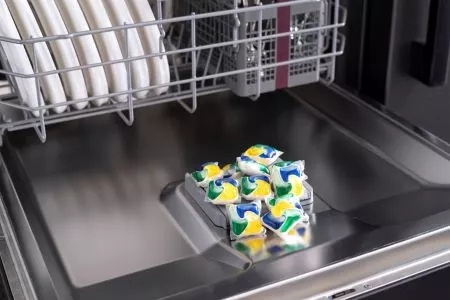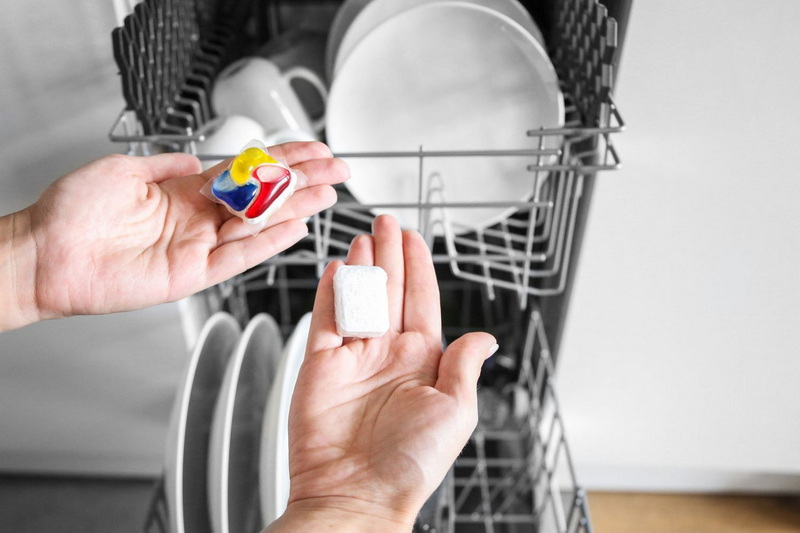Dongguan UFine Daily Chemical Co.,Ltd.
- All
- Product Name
- Product Keyword
- Product Model
- Product Summary
- Product Description
- Multi Field Search
Views: 222 Author: Tomorrow Publish Time: 11-01-2025 Origin: Site











Content Menu
● What are dishwasher pods made of?
● Do dishwasher pods release microplastics?
● How can consumers reduce microplastic exposure from dishwasher pods?
● Environmental trade-offs of dishwasher pods
● Lifecycle perspective and microplastic accounting
● Health and safety considerations
● Best practices for responsible consumption
● Regulatory and scientific considerations
● Case studies and recent findings
● Practical guidance for households
● Innovation and future directions
● FAQ
>> 1. Do dishwasher pods contain microplastics by design?
>> 2. How can I verify if a pod's film dissolves fully?
>> 3. Are there safer alternatives to avoid microplastics?
>> 4. Do dishwasher pods affect wastewater treatment differently than other plastics?
>> 5. What disposal practices minimize environmental impact?
Dishwasher pods are a popular convenience in modern households, designed to simplify the dishwashing process with pre-measured detergent and additives. However, concerns have grown about microplastics and other environmental impacts associated with these products. This article examines whether dishwasher pods contribute to microplastic pollution, what components of pods might pose risks, and how consumers can mitigate potential harm while maintaining cleaning effectiveness.

Dishwasher pods typically comprise several components:
- Detergent core: Surfactants, enzymes, builders, and enzymes to break down soils.
- Encapsulation: A water-soluble film, often polyvinyl alcohol (PVOH) or similar polymers, that dissolves in the wash.
- Additives: Brighteners, rinse aids, anti-spotting agents, and sometimes fragrance.
- Auxiliary ingredients: Stabilizers, corrosion inhibitors, and sometimes enzymes designed to target specific stains.
The key environmental question centers on the polymer film that encases the detergent. If the film is fully water-soluble and degrades in the wastewater system, the potential for microplastics entering the environment may be reduced. If fragments remain or the film is not fully degraded, there is concern about microplastic release.
The primary route for microplastics to enter waterways is through persistent plastic fragments from products that do not fully dissolve. In the case of dishwasher pods:
- The water-soluble film is designed to dissolve completely in the wash cycle. In most households, high water temperature and agitation aid dissolution.
- Some reports indicate that fragments of packaging or films can shed during handling, use, or disposal. If fragments bypass wastewater treatment or accumulate in sludge, they could contribute to microplastic pollution.
- The majority of standard dishwasher films are engineered to dissolve, but variability in formulation, storage conditions, and wash temperatures may influence dissolution efficiency.
Overall, dishwasher pods have the potential to contribute microplastics if the encapsulating film fails to fully dissolve or degrades into small fragments that persist. This risk is generally lower than that from non-dissolving plastics, but it is not negligible, particularly in regions with less advanced wastewater treatment.
If you are concerned about microplastics, consider the following options:
- Choose pods with fully water-soluble coatings known to dissolve rapidly in typical wash conditions. Look for certifications or third-party verifications indicating complete dissolution.
- Follow storage guidelines to minimize film breakage. Keep pods in their original packaging and away from moisture that could degrade films prematurely.
- Use appropriate dishwasher settings. Running at recommended temperatures and cycles promotes complete dissolution and reduces residue.
- Consider alternative detergent formats. Some users prefer liquid or powder detergents without encapsulating films; however, these formats may have their own environmental considerations.
- Proper disposal and recycling. While the pod film is designed to dissolve, recycle or dispose of packaging according to local regulations to minimize overall plastic waste.
Beyond microplastics, dishwasher pods raise other environmental considerations:
- Packaging plastic: Many pods are sold in plastic bags or rigid containers that contribute to plastic waste.
- Water hardness and additives: Some detergents contain phosphates or phosphonates, which can influence aquatic ecosystems. The industry has moved toward phosphate-free formulas, but regional regulations vary.
- Resource use: Pre-measured pods can reduce detergent waste but may require energy to manufacture and transport.
A balanced assessment weighs the potential for microplastics against the convenience, cleaning performance, and broader lifecycle impacts of the product.
To understand the environmental footprint of dishwasher pods, it helps to view their lifecycle:
- Material extraction: Production of plastic films and detergent ingredients consumes petroleum-based feedstocks and energy.
- Manufacturing: The encapsulation process and quality controls require water, heat, and chemical inputs.
- Transportation: Pods are typically lightweight, but packaging and distribution contribute to greenhouse gas emissions.
- Use phase: Dissolution behavior, wash temperatures, and water quality affect how much material enters wastewater.
- End-of-life: Packaging recycling rates and wastewater treatment practices determine the fate of residual materials.
If a pod's film dissolves completely, the risk of visible microplastic release diminishes, but dissolved microplastics or microbeads created during manufacturing may still contribute to dissolved organic particles in water, complicating measurement.

Apart from environmental concerns, consumer health and safety are relevant:
- Residuals in wastewater can interact with aquatic organisms, though many components are already common in consumer products.
- Allergens and fragrances in pods may affect susceptible individuals through indoor exposure or indirect environmental pathways.
- The potential for improper dosing or child-accessible packaging poses safety risks in households.
Regulatory bodies often require ingredient disclosures and safety assessments, encouraging manufacturers to minimize hazardous additives and improve packaging integrity.
- Read product labels and ingredient lists. Prefer products with transparent coatings that demonstrate dissolution in standard wash conditions.
- Support brands that publish third-party testing on dissolution and environmental impact.
- Use the minimum effective amount of detergent to reduce chemical load and packaging waste.
- Maintain the dishwasher to prevent leaks and ensure efficient operation, reducing waste and environmental impacts.
- Recycle packaging where possible and opt for brands with recycled-content packaging.
- Consider a product audit of your detergent portfolio to identify options with lower environmental footprints.
Regulatory bodies increasingly scrutinize plastic additives, film coatings, and wastewater outcomes. Research efforts focus on:
- The rate and completeness of dissolution for water-soluble films under realistic wash conditions.
- The fate of any film-derived fragments in sewer systems and treatment plants.
- The comparative contribution of dishwasher pods to overall microplastic load versus other consumer plastics.
Ongoing surveillance and independent testing help inform consumer choices and regulatory standards. International comparisons reveal that wastewater treatment efficiency significantly influences microplastic outcomes, with advanced facilities capturing a larger share of microplastics.
Recent studies have explored:
- Dissolution performance across brands under simulated household conditions, noting variability in coating integrity and rapidity of dissolution.
- Particle analysis of effluent from typical dishwashers showing trace microplastics that correlate with film composition.
- Comparisons between pod-based detergents and traditional liquid detergents in terms of plastic waste generation and film fragment release.
While findings vary, the consensus is that dissolution efficiency is a critical determinant of microplastic release, underscoring the value of quality assurance and consumer education.
- Test dissolution behavior: When trying a new pod brand, observe whether the coating fully dissolves within the first wash cycle.
- Store properly: Keep pods in dry, sealed packaging away from moisture to prevent premature film degradation.
- Use compatible machines and cycles: Some older or low-temperature washes may not fully dissolve certain coatings.
- Combine with soil-aware dosing: For heavily soiled loads, adjust washing parameters within manufacturer guidelines to ensure effective cleaning without overloading the system.
- Evaluate overall sustainability: Balance microplastic concerns with cleaning efficacy, energy use, and packaging waste to choose the most suitable option.
Industry players are exploring:
- Alternative biodegradable or fully dissolvable films that minimize any solid residues.
- Enhanced recycling programs and recyclable or compostable packaging materials.
- Digital labeling and QR verification of dissolution performance to aid consumer decision-making.
- Optimized formulations that reduce additives while maintaining cleaning performance.
Advances in material science and wastewater treatment will shape how future dishwasher pods interact with ecosystems and how regulators set standards.
Dishwasher pods can contribute microplastics if the encapsulating film does not fully dissolve during the wash cycle or breaks into persistent fragments. The risk varies with product formulation, storage, wash conditions, and regional wastewater capabilities. Consumers can mitigate potential microplastic release by selecting pods with proven dissolution, following storage and usage guidelines, and opting for packaging-conscious brands. While not the sole source of microplastics, dishwasher pods represent a manageable area for reducing plastic-related environmental impact through informed choice and responsible disposal.

Yes, if the encapsulating film fragments persist after dissolution, microplastic-like particles may be introduced into wastewater. However, many films are designed to dissolve completely.
Look for product documentation, third-party dissolution testing, or certifications indicating complete dissolution in standard wash conditions. Manufacturer testing data can provide insight.
Options include non-encapsulated detergents (liquids or powders) and brands emphasizing eco-friendly packaging and clear dissolution profiles. Consider regional regulations and personal cleaning needs.
They can, if fragments from films or packaging are released. In areas with advanced wastewater treatment, a larger portion of microplastics may be captured, reducing environmental release.
Keep pods and packaging dry and intact, follow local recycling guidelines for packaging, and use the smallest effective amount of detergent to reduce overall chemical and plastic load.